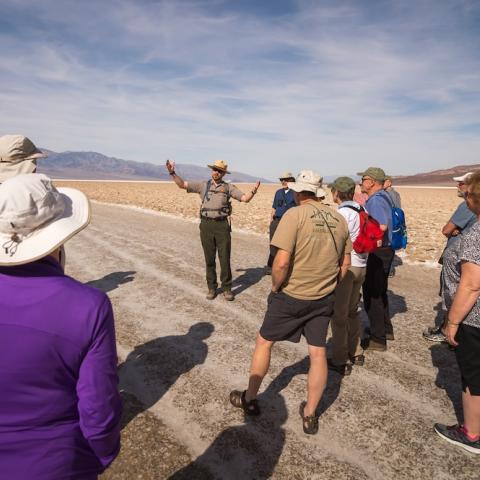
Workers have completed the cleanup of mud and debris that filled the swimming pool at Scotty's Castle in Death Valley/NPS
Roughly two months after torrential storms tore through Death Valley National Park, workers have many things back to normal in the park.
With the opening of a 30-mile stretch of the Badwater Road from Badwater to Harry Wade Junction this past Saturday, there now are 47 miles of the road open to visitors. Additionally, the Harry Wade Road has been graded and is open to allow through-travel in the southern part of the park.
That said, the Badwater Road/CA-178 from Harry Wade Junction to Shoshone remains closed pending repairs. Elsewhere in the park, the Mesquite Springs Campground has reopened, and repair work is progressing on the West Side and Warm Springs roads.
The Federal Highways Administration has received federal funding for repairs of the rest of Badwater Road and Scotty's Castle Road (aka North Highway or Bonnie Claire Road), but has yet to issue contracts for the repairs.
For an area that only receives about 2 inches of rain a year, the rains that fell from a series of storms that passed over Death Valley in mid-October were devastating. During a five-hour period, roughly 3.5 inches of rain fell on the northeast corner of Death Valley, including Grapevine Canyon, where Scotty's Castle is located.
Perhaps worst-hit by the storm October 18 was Scotty's Castle, an historic highlight in Death Valley's history. The castle is a magnificent mansion in the northern end of the park up Grapevine Canyon. Built back in 1922 by Albert Johnson, a Chicago insurance tycoon, the castle-like structure is named after Walter Scott, a desert rat who made a living by convincing investors to stake his supposed prospecting in Death Valley.
Officials expect it will take months to get the castle open again for tours.
According to the latest release from the park, here's an overview of the impact to Scotty's Castle:
* Visitor Center, Longshed and Hacienda buildings: Water flooded inside these buildings. Mud and debris 1-4 feet thick has been removed from inside the buildings by hand crews. A structural wall in the visitor center (historic garage) was broken and pushed off its foundation. All carpets, drywall, exhibits, utilities, and office equipment have been removed and will need to be replaced. The bookstore sales inventory was destroyed.
* Scotty’s Castle (Main House): Without a functioning HVAC system, historic furniture, archives and other museum collections are threatened by mold, rodents, dust, and lack of a fire suppression system. Fortunately, the building itself sustained only minor damage from roof leaks.
* Historic Bridge: The bridge moved slightly but is structurally sound.
* Historic Pool: The pool was filled with mud, which has been removed. Grounds: Crews have removed 100,000 cubic feet of flood debris from the historic district. A lot of this had to be done by hand to reduce risk of damaging historic features. Miles of historic fence line will need to be replaced and repaired.
* Water system: Flooding destroyed a water treatment facility, reservoir, spring house, and water line. The spring has been cleaned out and a temporary water line should be in place within a few weeks.
* Electricity: Twenty-four power poles were destroyed.
* Propane: The propane line is broken.
* Picnic area: The flood destroyed the lawn, sprinkler system, and picnic tables.
Death Valley officials are concerned that this winter's El Niño weather pattern could bring more flooding to the park. If there's an upside from all that rain, next spring's wildflower bloom could be incredible.




 Support Essential Coverage of Essential Places
Support Essential Coverage of Essential Places






